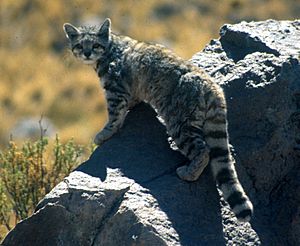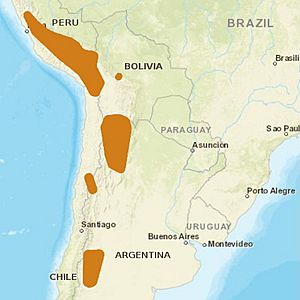Andean mountain cat facts for kids
Quick facts for kids Andean mountain cat |
|
|---|---|
 |
|
| Conservation status | |
| Scientific classification | |
| Genus: |
Leopardus
|
| Species: |
jacobita
|
 |
|
| Distribution of the Andean cat, 2016 | |
| Synonyms | |
|
Oreailurus jacobita |
|
The Andean mountain cat (also called Leopardus jacobita) is a small wild cat. It lives high up in the Andes mountains. There are fewer than 1,500 of these cats left in the wild. Because of this, it is listed as an Endangered animal. Many local people, like the Aymara and Quechua people, see this cat as a special, sacred animal.
A scientist named Emilio Cornalia first described this cat in 1865. He named it after Jacobita Mantegazza. It is a unique species, meaning it's the only one of its kind in its group.
Contents
What Does the Andean Cat Look Like?
The Andean mountain cat has soft, ashy-gray fur. Its head is gray, and its ears are rounded. The nose and lips are black. White fur surrounds these black areas. Two dark brown lines run from its eyes across its cheeks.
Body Markings and Size
This cat has black spots on its front legs. Yellowish-brown blotches appear on its sides. Its back legs have one or two thin, dark rings. The cat's long, bushy tail has six to nine dark brown to black rings. Young cats have darker and smaller markings than adult cats.
The hair on its back and tail is about 4 to 4.5 centimeters (about 1.5 to 1.7 inches) long. Its rounded paw prints are about 4 cm (1.5 in) long and 3.5 cm (1.3 in) wide. The pads of its paws are covered with hair.
Adult Andean mountain cats are about 57.7 to 85 cm (22.7 to 33.5 in) long from head to body. Their tails are about 41.3 to 48.5 cm (16.2 to 19 in) long. They stand about 36 cm (14 in) tall at the shoulder. An adult cat can weigh up to 5.5 kilograms (12 pounds).
Andean Cat vs. Pampas Cat
The Andean mountain cat and the pampas cat look very similar. This makes it hard to tell them apart in the wild. It also makes it difficult to count how many of each cat species there are. Knowing the differences helps scientists get better information.
| Andean Cat | Feature | Pampas Cat |
|---|---|---|
| About two-thirds of its body length. It is thick and blunt with 6 to 9 wide rings. | Tail | About half of its body length. It is thin and pointed with 9 thin rings. |
| Tail rings can be up to 60 mm (2.3 in) wide. | Tail Rings | Tail rings are up to 20 mm (0.7 in) wide. |
| Clear lines on the sides of the eyes. Ears have rounded tips. | Face | Lines, if present, are brown and less clear. Most have ears with pointed tips. |
| Very dark or black. | Nose | Light colored, usually pink. |
| Yellow, rust, gray, or black. | Overall Color | Cream, red, rust, and black. |
| One main fur pattern. | Fur Pattern | Three different fur patterns with many variations. |
| Ears are one solid color. | Ear Color | Ears have patterns. |
| Rings are not complete; stripes look like spots. | Front Paws | Two or more clear, complete, black rings. |
Where Do Andean Cats Live?
The Andean mountain cat lives only in the high Andes mountains. In Argentina, they live at elevations from 1,800 meters (about 5,900 feet) high. In Chile, Bolivia, and central Peru, they can be found over 4,000 meters (about 13,000 feet) high.
Their Mountain Home
Their home is dry, rocky, and steep. There are not many plants. This shows that the Andean mountain cat likes a cool, dry, land-based home.
In one area of Chile, the Salar de Surire Natural Monument, only about five cats were found in a 250 square kilometer (96 square mile) area. In northwestern Argentina, scientists found about seven to twelve cats in a 100 square kilometer (38 square mile) area. This was at an elevation of about 4,200 meters (13,700 feet).
Deep valleys in the Andes break up their habitat. Their favorite food, mountain viscachas, live in small, separate groups. This makes it harder for the cats to find food.
Andean Cat Behavior and Diet
The Andean cat lives in the same areas as the pampas cat and the cougar. Both the Andean cat and the pampas cat eat mountain viscachas. For the Andean cat, viscachas make up most of the food they eat.
What They Hunt
Even though viscachas are a big part of their diet, the Andean cat also hunts other animals. These include small reptiles, birds, and other small mammals like tuco-tuco.
Both Andean cats and pampas cats often hunt at night. They are seen most often on nights when there is no moon. They are also seen during full moons, but less often.
Family Life
People living in the Andes have seen Andean cats with their young. This suggests that their mating season might be in July and August. However, kittens have been seen in April and October. This means the mating season could last longer, possibly into November or December.
A mother cat usually has one or two kittens. They are born in the spring and summer months. This is common for many animals. Having young when food is plentiful helps the kittens survive.
Threats to Andean Cats
The Andean cat faces several dangers. These include losing their homes and their natural areas becoming damaged. They are also threatened by hunting and diseases.
Protecting the Andean Cat
The Andean Cat is listed as an endangered animal. It is protected by several international groups, including the IUCN Red List and CITES Appendix I. It is also protected by laws in all the countries where it lives.
Andean Cat Alliance
In 2003, the Andean Cat Alliance was formed. This group includes people from Argentina, Bolivia, Peru, and Chile. Their goal is to study and protect the Andean cat.
| Country | Law or Policy | What it Does | Year Started | Protected Areas | Sightings in Protected Areas | Areas Not Yet Checked |
|---|---|---|---|---|---|---|
| Argentina | National Law 22421 of Wildlife Conservation | Stops hunting and trading of the Andean cat | 1981, 1997, and 1986 | 9 | Found in 7 areas | 1 not checked, 1 partly checked |
| Statutory Decree 666/97 | ||||||
| Resolution No. 63/86 of the Secretary of Agriculture | ||||||
| Bolivia | Decree No. 22421 | Stops hunting, catching, and selling wild animals and their parts | 1990 | 8 | Found in 6 areas | 2 not checked |
| Chile | Law No. 19473 | Stops hunting all wild cats. Punishments include fines and jail time. | 1972 | 7 | Found in all 7 areas | All areas checked |
| Peru | Supreme Decree No. 013-99-AG | Stops hunting, trading, and owning living or dead Andean cats or their body parts | 1999 | 12 | Found in 4 areas | 8 not checked |
See also
 In Spanish: Gato andino para niños
In Spanish: Gato andino para niños



